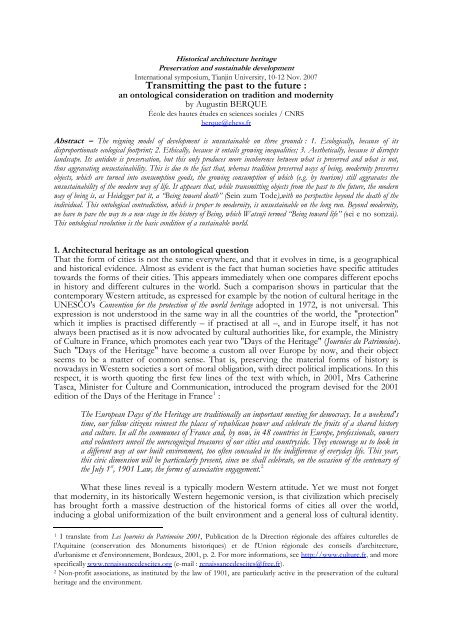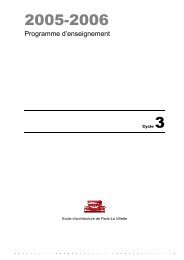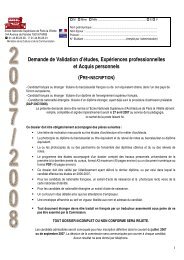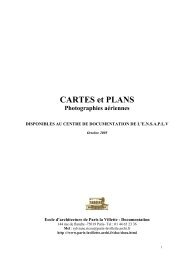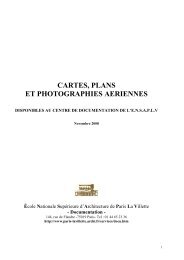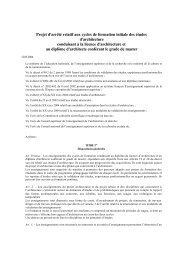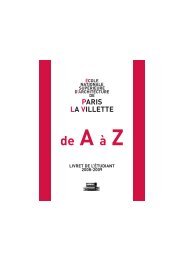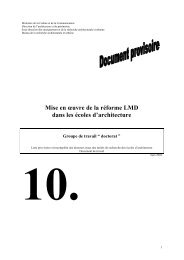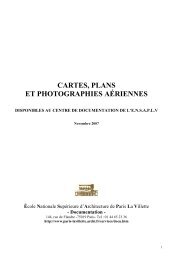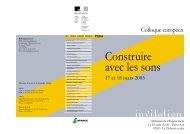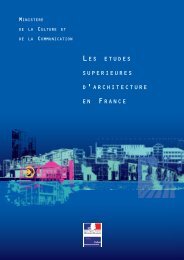Transmitting the past to the future : - Ecole Nationale Supérieure d ...
Transmitting the past to the future : - Ecole Nationale Supérieure d ...
Transmitting the past to the future : - Ecole Nationale Supérieure d ...
Create successful ePaper yourself
Turn your PDF publications into a flip-book with our unique Google optimized e-Paper software.
His<strong>to</strong>rical architecture heritage<br />
Preservation and sustainable development<br />
International symposium, Tianjin University, 10-12 Nov. 2007<br />
<strong>Transmitting</strong> <strong>the</strong> <strong>past</strong> <strong>to</strong> <strong>the</strong> <strong>future</strong> :<br />
an on<strong>to</strong>logical consideration on tradition and modernity<br />
by Augustin BERQUE<br />
École des hautes études en sciences sociales / CNRS<br />
berque@ehess.fr<br />
Abstract – The reigning model of development is unsustainable on three grounds : 1. Ecologically, because of its<br />
disproportionate ecological footprint; 2. Ethically, because it entails growing inequalities; 3. Aes<strong>the</strong>tically, because it disrupts<br />
landscape. Its antidote is preservation, but this only produces more incoherence between what is preserved and what is not,<br />
thus aggravating unsustainability. This is due <strong>to</strong> <strong>the</strong> fact that, whereas tradition preserved ways of being, modernity preserves<br />
objects, which are turned in<strong>to</strong> consumption goods, <strong>the</strong> growing consumption of which (e.g. by <strong>to</strong>urism) still aggravates <strong>the</strong><br />
unsustainability of <strong>the</strong> modern way of life. It appears that, while transmitting objects from <strong>the</strong> <strong>past</strong> <strong>to</strong> <strong>the</strong> <strong>future</strong>, <strong>the</strong> modern<br />
way of being is, as Heidegger put it, a “Being <strong>to</strong>ward death” (Sein zum Tode),with no perspective beyond <strong>the</strong> death of <strong>the</strong><br />
individual. This on<strong>to</strong>logical contradiction, which is proper <strong>to</strong> modernity, is unsustainable on <strong>the</strong> long run. Beyond modernity,<br />
we have <strong>to</strong> pave <strong>the</strong> way <strong>to</strong> a new stage in <strong>the</strong> his<strong>to</strong>ry of Being, which Watsuji termed “Being <strong>to</strong>ward life” (sei e no sonzai).<br />
This on<strong>to</strong>logical revolution is <strong>the</strong> basic condition of a sustainable world.<br />
1. Architectural heritage as an on<strong>to</strong>logical question<br />
That <strong>the</strong> form of cities is not <strong>the</strong> same everywhere, and that it evolves in time, is a geographical<br />
and his<strong>to</strong>rical evidence. Almost as evident is <strong>the</strong> fact that human societies have specific attitudes<br />
<strong>to</strong>wards <strong>the</strong> forms of <strong>the</strong>ir cities. This appears immediately when one compares different epochs<br />
in his<strong>to</strong>ry and different cultures in <strong>the</strong> world. Such a comparison shows in particular that <strong>the</strong><br />
contemporary Western attitude, as expressed for example by <strong>the</strong> notion of cultural heritage in <strong>the</strong><br />
UNESCO's Convention for <strong>the</strong> protection of <strong>the</strong> world heritage adopted in 1972, is not universal. This<br />
expression is not unders<strong>to</strong>od in <strong>the</strong> same way in all <strong>the</strong> countries of <strong>the</strong> world, <strong>the</strong> "protection"<br />
which it implies is practised differently – if practised at all –, and in Europe itself, it has not<br />
always been practised as it is now advocated by cultural authorities like, for example, <strong>the</strong> Ministry<br />
of Culture in France, which promotes each year two "Days of <strong>the</strong> Heritage" (Journées du Patrimoine).<br />
Such "Days of <strong>the</strong> Heritage" have become a cus<strong>to</strong>m all over Europe by now, and <strong>the</strong>ir object<br />
seems <strong>to</strong> be a matter of common sense. That is, preserving <strong>the</strong> material forms of his<strong>to</strong>ry is<br />
nowadays in Western societies a sort of moral obligation, with direct political implications. In this<br />
respect, it is worth quoting <strong>the</strong> first few lines of <strong>the</strong> text with which, in 2001, Mrs Ca<strong>the</strong>rine<br />
Tasca, Minister for Culture and Communication, introduced <strong>the</strong> program devised for <strong>the</strong> 2001<br />
edition of <strong>the</strong> Days of <strong>the</strong> Heritage in France 1 :<br />
The European Days of <strong>the</strong> Heritage are traditionally an important meeting for democracy. In a weekend's<br />
time, our fellow citizens reinvest <strong>the</strong> places of republican power and celebrate <strong>the</strong> fruits of a shared his<strong>to</strong>ry<br />
and culture. In all <strong>the</strong> communes of France and, by now, in 48 countries in Europe, professionals, owners<br />
and volunteers unveil <strong>the</strong> unrecognized treasures of our cities and countryside. They encourage us <strong>to</strong> look in<br />
a different way at our built environment, <strong>to</strong>o often concealed in <strong>the</strong> indifference of everyday life. This year,<br />
this civic dimension will be particularly present, since we shall celebrate, on <strong>the</strong> occasion of <strong>the</strong> centenary of<br />
<strong>the</strong> July 1 st , 1901 Law, <strong>the</strong> forms of associative engagement. 2<br />
What <strong>the</strong>se lines reveal is a typically modern Western attitude. Yet we must not forget<br />
that modernity, in its his<strong>to</strong>rically Western hegemonic version, is that civilization which precisely<br />
has brought forth a massive destruction of <strong>the</strong> his<strong>to</strong>rical forms of cities all over <strong>the</strong> world,<br />
inducing a global uniformization of <strong>the</strong> built environment and a general loss of cultural identity.<br />
1 I translate from Les Journées du Patrimoine 2001, Publication de la Direction régionale des affaires culturelles de<br />
l'Aquitaine (conservation des Monuments his<strong>to</strong>riques) et de l'Union régionale des conseils d'architecture,<br />
d'urbanisme et d'environnement, Bordeaux, 2001, p. 2. For more informations, see http://www.culture.fr, and more<br />
specifically www.renaissancedescites.org (e-mail : renaissancedescites@free.fr).<br />
2 Non-profit associations, as instituted by <strong>the</strong> law of 1901, are particularly active in <strong>the</strong> preservation of <strong>the</strong> cultural<br />
heritage and <strong>the</strong> environment.
2<br />
This uniformization and loss of identity of cities is even more pronounced in countries which<br />
belong <strong>to</strong> o<strong>the</strong>r traditions than <strong>the</strong> European one, and which, for that reason, adopted <strong>the</strong><br />
modern Western civilizational paradigm later than its European cradle. As a matter of fact, from<br />
a very general point of view, it can be said that a reaction against <strong>the</strong> modern uniformization and<br />
loss of identity of cities emerged earlier in Europe than elsewhere in <strong>the</strong> world precisely because<br />
Europe modernized earlier. Accordingly, such attitudes as expressed in Mrs Tasca's text have<br />
emerged later in o<strong>the</strong>r parts of <strong>the</strong> world, or are still due <strong>to</strong> emerge.<br />
In o<strong>the</strong>r words, modernity produces sooner or later <strong>the</strong> counter-effects or <strong>the</strong> antidotes<br />
of its paradigm inasmuch as this paradigm is effective. This is certainly true <strong>to</strong> some degree, if<br />
one examines <strong>the</strong> his<strong>to</strong>ry of ideas and practices relating <strong>to</strong> <strong>the</strong> preservation of urban forms in<br />
Europe itself and in o<strong>the</strong>r parts of <strong>the</strong> world. Yet, it is no less evident that, even before <strong>the</strong><br />
modern Western civilizational paradigm established itself, and still after its imposition in different<br />
parts of <strong>the</strong> world, <strong>the</strong>re were and are various types of human attitudes <strong>to</strong>ward his<strong>to</strong>rical forms.<br />
According <strong>to</strong> culture, identity is not unders<strong>to</strong>od and performed in <strong>the</strong> same ways. What is a<br />
heritage, what is a monument, what is <strong>to</strong> be preserved does not mean <strong>the</strong> same thing in, say, Paris<br />
and Beijing.<br />
This entails that, when speaking of such things, one has <strong>to</strong> combine two apparently<br />
contradic<strong>to</strong>ry approaches. One relates in universal terms <strong>to</strong> <strong>the</strong> global effects and counter-effects<br />
of <strong>the</strong> modern paradigm; which is <strong>to</strong> say that more or less <strong>the</strong> same problems exist or will arise<br />
everywhere in <strong>the</strong> world, and that we have <strong>to</strong> deal with <strong>the</strong>m in common terms, exchanging our<br />
experiences and emulating each o<strong>the</strong>r for a better quality of <strong>the</strong> environment all over <strong>the</strong> world.<br />
The second approach relates <strong>to</strong> <strong>the</strong> foundations of <strong>the</strong>se very terms which we deem <strong>to</strong> be<br />
common, like "heritage", "monument" or "preservation", and which in fact are not common;<br />
<strong>the</strong>y always have a singular meaning, simply because human beings are not <strong>the</strong> same everywhere<br />
at any time. Beijing is not Paris because <strong>the</strong> Chinese are not French, and one should not overlook<br />
this difference, precisely because, through heritage and monuments, it is cultural identity, that is,<br />
a way of being, which is at stake.<br />
Yet we cannot content ourselves with juxtaposing <strong>the</strong>se two contradic<strong>to</strong>ry approaches.<br />
This leads nowhere else than <strong>to</strong> fur<strong>the</strong>r contradictions and misunderstandings, be it on a national<br />
or an international plane. We have <strong>to</strong> overcome, in this respect, <strong>the</strong> apparent incompatibility of<br />
<strong>the</strong> universal and <strong>the</strong> singular. This paper intends <strong>to</strong> suggest that it is not impossible, provided<br />
that we recognize that such an overcoming is not only a technical and political, but an on<strong>to</strong>logical<br />
problem; that is, a matter of being and existence.<br />
2. How <strong>the</strong> modern notion of heritage emerged in Europe<br />
The rapid transformation of <strong>the</strong> environment, particularly that of cities, which, starting with<br />
Great Britain, was entailed by modern industry in European countries, soon induced various<br />
forms of reaction against <strong>the</strong>se transformations. Yet, even before <strong>the</strong>se material effects, a<br />
reaction against modern universalism had already occurred as soon as <strong>the</strong> second half of <strong>the</strong> 18 th<br />
century, enhancing <strong>the</strong> respective peculiarity of different cultures; e.g. Johann Gottfried Herder<br />
(1744-1803) 's Auch eine Philosophie der Geschichte zur Bildung der Menschheit (Ano<strong>the</strong>r philosophy of <strong>the</strong><br />
his<strong>to</strong>rical formation of Humankind, 1774) and Ideen zur Geschichte der Menschheit (Ideas for a his<strong>to</strong>ry of<br />
Humankind, 1784). Romanticism gave a general background <strong>to</strong> both types of reactions. This trend<br />
of ideas developed in <strong>the</strong> 19 th century in<strong>to</strong> such works as, in Great Britain, those of John Ruskin<br />
(1819-1900) and William Morris (1834-1896), who inspired <strong>the</strong> creation of <strong>the</strong> Arts and Crafts<br />
Exhibition Society in 1888, or in France those of Eugène Viollet-le-Duc (1814-1879), known<br />
among o<strong>the</strong>rs for his res<strong>to</strong>ration of <strong>the</strong> mediaeval forms of <strong>the</strong> city of Carcassonne, <strong>the</strong> works of<br />
which were conducted from 1844 <strong>to</strong> 1910. Toward <strong>the</strong> end of <strong>the</strong> 19 th century, this trend of ideas<br />
had grown up in<strong>to</strong> an important current in city planning, which was illustrated in Austria by<br />
Camillo Sitte (1843-1903)'s Der Städtebau nach seinen künstlerischen Grundsätzen (Artistic principles of<br />
<strong>to</strong>wn planning, 1889). It had also brought forth a general reflection about <strong>the</strong> nature of monuments<br />
and <strong>the</strong>ir role in modern society, as illustrated in <strong>the</strong> Viennese his<strong>to</strong>rian Alois Riegl's Der moderne<br />
Denkmal Kultus (The modern cult of monuments, 1903). 3<br />
Through such works and <strong>the</strong>ir influence, it can be said that <strong>the</strong> general frame of <strong>the</strong><br />
modern attitude <strong>to</strong>ward <strong>the</strong> preservation of <strong>the</strong> built heritage was already set by 1900. It was<br />
3 More details about this general trend of ideas and practises in Yannis TSIOMIS et al., Ville-Cité. Des patrimoines<br />
européens, Paris : Picard, 1998.
3<br />
implemented through diverse laws in <strong>the</strong> 20 th century, leading <strong>to</strong> <strong>the</strong> convention enacted in 1972<br />
by <strong>the</strong> UNESCO. However, one must not overlook <strong>the</strong> fact that this attitude was far from being<br />
<strong>the</strong> only possible one in <strong>the</strong> Western world. On <strong>the</strong> one hand, until <strong>the</strong> Renaissance, such an<br />
attitude was unknown in Europe. On <strong>the</strong> o<strong>the</strong>r hand, preserving <strong>the</strong> urban environment as a<br />
cultural heritage had very strong adverse fac<strong>to</strong>rs and opponents in <strong>the</strong> very nature of modernity,<br />
as was expressed by what Françoise Choay has called l'urbanisme progressiste. 4 It can be said, for<br />
example, that Le Corbusier (Charles-Édouard Jeanneret, 1887-1965)'s attitude was anti<strong>the</strong>tic <strong>to</strong><br />
that of Camillo Sitte (whom Choay considers as a paragon of l'urbanisme culturaliste). In his Plan<br />
pour une ville contemporaine de 3 millions d'habitants (Plan for a contemporary city of 3 million inhabitants,<br />
1922), later evolved in<strong>to</strong> his Plan Voisin de Paris (Voisin plan for Paris, 1925) 5 , he proposed no less<br />
than scrapping <strong>the</strong> existing forms of Paris and replacing <strong>the</strong>m with <strong>the</strong> wide geometrical forms of<br />
sky scrapers along orthogonal avenues, only interspersed here and <strong>the</strong>re with a few monuments<br />
like Notre-Dame ca<strong>the</strong>dral, preserved in <strong>the</strong>ir original form.<br />
That <strong>the</strong> Plan Voisin appeared at <strong>the</strong> time as a provocation and was eventually not<br />
adopted in Paris must not hide <strong>the</strong> fact that it expressed <strong>the</strong> essence of modernity in urban<br />
matters. That is, <strong>to</strong> scrap on <strong>the</strong> one hand, and <strong>to</strong> freeze on <strong>the</strong> o<strong>the</strong>r hand. This juxtaposition of<br />
scrapping and freezing has been performed in various and variable balances all over <strong>the</strong> world in<br />
<strong>the</strong> 20 th century, and it is still going on ; e.g., for more scrapping than freezing, in capitals like<br />
Beijing, or for more freezing than scrapping, in capitals like Paris. In such a juncture, what is not<br />
taken in<strong>to</strong> account is something which <strong>the</strong> pre-modern his<strong>to</strong>ry of cities had brought forth: urban<br />
composition, as a harmonious material expression of urbanity.<br />
We shall come back <strong>to</strong> this question in part 4, while stressing that it is not conceivable,<br />
and even less practicable, in <strong>the</strong> on<strong>to</strong>logical paradigm of modernity. Yet before that, we must<br />
delve a little fur<strong>the</strong>r in<strong>to</strong> <strong>the</strong> reasons which have led <strong>to</strong> <strong>the</strong> modern juxtaposition of scrapping or<br />
freezing urban forms.<br />
As Choay's classical study L'Allégorie du patrimoine (The allegory of heritage) 6 has shown, <strong>the</strong><br />
modern idea of his<strong>to</strong>rical monument (Denkmal in Riegl's sense) can be said <strong>to</strong> have appeared in<br />
Rome about 1420. 7 Before <strong>the</strong> Renaissance, people did not feel any distance <strong>to</strong>ward ancient<br />
forms, architectural or o<strong>the</strong>rs. This is why, in mediaeval times, <strong>the</strong>y could use <strong>the</strong> s<strong>to</strong>nes of<br />
antique buildings, such as <strong>the</strong> Colosseum, for contemporary necessities. This attitude was shared<br />
by all pre-modern societies. For example, s<strong>to</strong>nes from <strong>the</strong> Pyramids were used by <strong>the</strong> Arabs for<br />
building Fustat (Cairo). What happened at <strong>the</strong> Renaissance was a mise en his<strong>to</strong>ire ; that is, <strong>the</strong><br />
emergence of a sense of distance in time, which Choay aptly relates with <strong>the</strong> emergence of<br />
modern perspective in painting. Both in time and in space, an essential difference was<br />
progressively introduced between what was <strong>to</strong> become later, in on<strong>to</strong>logical terms, <strong>the</strong> subject and<br />
<strong>the</strong> object, and which until <strong>the</strong>n had been felt as one same reality. As for his<strong>to</strong>ry, this sense of<br />
distance was first expressed in Francesco Petrarca (1304-1374) 's Africa (1338), in which Antiquity<br />
appears as something saint and sacred in itself, and by this very fact, in an essential o<strong>the</strong>rness. 8<br />
This was initially limited <strong>to</strong> <strong>the</strong> study of ancient literature, but later, Filippo Brunelleschi (1377-<br />
1446) introduced <strong>the</strong> same state of mind - that is, his<strong>to</strong>rical distance - in <strong>the</strong> discovery of <strong>the</strong><br />
proper identity of ancient architectural forms. 9<br />
At that time was born <strong>the</strong> his<strong>to</strong>rical movement which led progressively <strong>to</strong> <strong>the</strong> attitude<br />
which we have seen above; that is, <strong>to</strong> respect <strong>the</strong> very his<strong>to</strong>ricity of ancient forms. At <strong>the</strong> same<br />
time occurred a transformation of <strong>the</strong> notion of monument. The Latin word monumentum derives<br />
from <strong>the</strong> verb monere, itself derived from <strong>the</strong> Indo-European root men-, meaning <strong>the</strong> movement of<br />
<strong>the</strong> mind (as a matter of fact, <strong>the</strong> English words "meaning" and "mind" both derive from that<br />
same root). The initial meaning of monere is "<strong>to</strong> remind"; and accordingly, monumentum meant<br />
anything reminding of something, especially in written form. It is for example in this sense that it<br />
is used in Horatius' (Quintus Horatius Flaccus, 65-8 BC) famous expression Exegi monumentum<br />
aere perennius ("I achieved a monument more durable than bronze"), at <strong>the</strong> end of <strong>the</strong> third book<br />
of his Odes. Only in <strong>the</strong> 18 th century did <strong>the</strong> word "monument" acquire its essential meaning<br />
4 Françoise CHOAY, L'Urbanisme, u<strong>to</strong>pies et réalités. Une anthologie, Paris : Seuil, 1965.<br />
5 “Voisin” here is a place name (that of a plane fac<strong>to</strong>ry), and does not mean “neighbour”, as often mistranslated.<br />
6 Paris : Seuil, 1992.<br />
7 Op. cit., p. 26.<br />
8 Op. cit., p. 38 sq.<br />
9 Op. cit., p. 40 sq.
4<br />
nowadays, i.e. that of a material building of remarkable size and/or age; and only in <strong>the</strong> 20 th<br />
century did whole sets of material buildings, i.e. urban environments, acquire <strong>the</strong> status of<br />
his<strong>to</strong>rical monuments, as such <strong>to</strong> be protected and preserved in <strong>the</strong>ir initial forms. That is, frozen.<br />
3. The limits of <strong>the</strong> modern Western paradigm<br />
This modern transformation corresponds <strong>to</strong> <strong>the</strong> on<strong>to</strong>logical shift, analysed by Martin Heidegger<br />
(1889-1976) in Sein und Zeit (1927), from Geschichtlichkeit <strong>to</strong> His<strong>to</strong>rischkeit; that is, from lived his<strong>to</strong>ry<br />
<strong>to</strong> objectified his<strong>to</strong>ry. In o<strong>the</strong>r words, it corresponds <strong>to</strong> <strong>the</strong> emergence of modern dualism. It is<br />
this shift which made possible <strong>the</strong> emergence of <strong>the</strong> respect of ancient built environments as<br />
his<strong>to</strong>rical monuments, and which, consequently, brought forth modern conservational policies<br />
such as those advocated by <strong>the</strong> UNESCO's convention of 1972.<br />
Now, <strong>the</strong>re is an essential contradiction in this attitude; because it supposes, on <strong>the</strong> one<br />
hand, <strong>the</strong> capacity <strong>to</strong> recognize <strong>the</strong> proper his<strong>to</strong>rical value of certain built forms, that is, <strong>the</strong><br />
intrinsic value of objects, as distinct from <strong>the</strong> subjective interests of contemporary people, while<br />
on <strong>the</strong> o<strong>the</strong>r hand it is advocated in <strong>the</strong> name of <strong>the</strong> cultural identity of those same people; that is,<br />
it implies a negation of that very dualism which made possible <strong>the</strong> emergence of <strong>the</strong> modern<br />
notions of monument and heritage.<br />
A good example of this aporia can be found in a reflection made in 1987 by Mrs Choay at<br />
<strong>the</strong> occasion of a bilateral, French and Japanese symposium on La Qualité de la ville / Toshi ni kosei<br />
wo 都 市 に 個 性 を (The quality of <strong>the</strong> city): "Whe<strong>the</strong>r prevails <strong>the</strong> symbolic permanence of <strong>the</strong> form<br />
in space or that of <strong>the</strong> matter in time, in any case it is that same kind of conservation, universal<br />
and identifica<strong>to</strong>ry, which <strong>the</strong> question is about". 10 Choay's expression "<strong>the</strong> symbolic permanence<br />
of <strong>the</strong> form in space" alludes <strong>to</strong> <strong>the</strong> famous case of <strong>the</strong> temples of Ise shrine (Ise jingo 伊 勢 神 宮 ),<br />
in Japan, which are ritually rebuilt with new material (hinoki 檜 , or Japanese cypress) every<br />
twentieth year in <strong>the</strong>ir initial form, dating back <strong>to</strong> Antiquity. 11 She opposes this pratice of<br />
monumentality <strong>to</strong> <strong>the</strong> European one, in which preserving <strong>the</strong> au<strong>the</strong>nticity of <strong>the</strong> initial material is<br />
more important, be it in <strong>the</strong> form of ruins, that is, at <strong>the</strong> expense of <strong>the</strong> initial form. Though<br />
interesting and profound Choay's reflection may be, it remains <strong>to</strong>tally circumscribed within <strong>the</strong><br />
modern classical Western paradigm, that of Descartes and New<strong>to</strong>n, which presupposes <strong>the</strong><br />
universalness of space and time, and which <strong>the</strong>refore is about <strong>the</strong> form and/or <strong>the</strong> matter of<br />
objects. 12 Here lies <strong>the</strong> aporia, since, at <strong>the</strong> same time, Choay speaks of an "identifica<strong>to</strong>ry"<br />
function of such objects; which implies a transgression of <strong>the</strong> modern duality between subject<br />
and object. In Heideggerian terms, <strong>the</strong> identification of a society with its monuments belongs <strong>to</strong><br />
<strong>the</strong> dimension of <strong>the</strong> geschichtlich, and <strong>the</strong>refore has nothing <strong>to</strong> do with <strong>the</strong> universalness of space<br />
and/or time, which on <strong>the</strong> contrary belongs <strong>to</strong> <strong>the</strong> dimension of <strong>the</strong> his<strong>to</strong>risch. In terms of<br />
Geschichtlichkeit, <strong>the</strong>re is nothing like "universal space and/or time", which is an abstract, modern<br />
prerequisite for <strong>the</strong> existence of objects as such; what <strong>the</strong>re is, is <strong>the</strong> concreteness of things in <strong>the</strong><br />
"country" (Gegend) of existence, in which nei<strong>the</strong>r subject and object, matter and form, nor space<br />
and time, can be dissociated.<br />
As a matter of fact, <strong>the</strong> periodic reconstruction of Ise shrine is an exemplary expression<br />
of Geschichtlichkeit as an absolute negation of that his<strong>to</strong>rical distance which - as Choay herself has<br />
made clear - appeared in Europe at <strong>the</strong> Renaissance; because ancient forms are here indefinitely<br />
enacted as if <strong>the</strong>y were present forms. This is not all. Such enaction of <strong>the</strong> ancient through <strong>the</strong><br />
10 "Que prévale la permanence symbolique de la forme dans l'espace ou celle de la matière dans le temps, dans l'un et<br />
l'autre cas, c'est du même genre de conservation, universelle et identifica<strong>to</strong>ire qu'il s'agit". Françoise CHOAY,<br />
'Mémoire de la ville et monumentalité', in Augustin BERQUE (ed.) La Qualité de la ville. Urbanité française, urbanité<br />
nippone, Tokyo : Maison franco-japonaise, 1987, p. 123. For more comparisons of <strong>the</strong> monumentality of Ise with a<br />
European counterpart (namely <strong>the</strong> Roman <strong>the</strong>rms of Cluny in Paris), see Augustin BERQUE, Japan : Cities and Social<br />
Bonds, Yelver<strong>to</strong>ft Manor : Pilking<strong>to</strong>n, 1997 (Du Geste à la cité. Formes urbaines et lien social au Japon, Paris : Gallimard,<br />
1993), chap. I ('Devenir : ville japonaise, espace-temps'), and Augustin BERQUE, Toshi no kosumorojî. Nichi-Bei-Ou<br />
<strong>to</strong>shi hikaku, 都 市 のコスモロジー. 日 米 欧 都 市 比 較 , Tokyo : Kodansha gendai shinsho, 1993, chap. I<br />
('Yurianusu no yokujô <strong>to</strong> Ise jingû ユリアヌスの 浴 場 と 伊 勢 神 宮 ').<br />
11 The shrine originates in <strong>the</strong> transfer of <strong>the</strong> cult of <strong>the</strong> Sun goddess Amaterasu Oomikami 天 照 大 神 from Yama<strong>to</strong><br />
大 和 <strong>to</strong> Ise <strong>to</strong>ward <strong>the</strong> end of <strong>the</strong> 5 th or <strong>the</strong> beginning of <strong>the</strong> 6 th century. The rite of reconstructing <strong>the</strong> main temple<br />
every twentieth year was established under <strong>the</strong> reign of Temmu ( 天 武 , died in 686).<br />
12 For an interpretation of this same problem in terms of his<strong>to</strong>ry of science, see Alexandre KOYRE's classical study<br />
From <strong>the</strong> closed world <strong>to</strong> <strong>the</strong> infinite universe, Baltimore : John Hopkins Press, 1957.
5<br />
present, in its turn, is an absolute negation of dualism; because <strong>the</strong> form which is at stake here is,<br />
indissociably, that of <strong>the</strong> building which is built and that of <strong>the</strong> rite by dint of which it is built.<br />
Now, a rite is a social performance, i.e. that of acting human subjects; and this performance is<br />
nothing else than a form in time. This is <strong>to</strong> say that what is going on at Ise is much more than <strong>the</strong><br />
his<strong>to</strong>risch production of an objective form in space; it is an illustration of <strong>the</strong> congenial, geschichtlich<br />
link of things and people in <strong>the</strong> country of existence.<br />
The case of Ise illustrates something utterly alien <strong>to</strong> <strong>the</strong> categories of modern thought;<br />
that is, <strong>the</strong> fact that <strong>the</strong> form of a thing is not limited <strong>to</strong> its objective, material and measurable<br />
appearance, since it implies human existence. In <strong>the</strong> conceptual tradition of East Asia, this idea<br />
was expressed in various ways, for example by Zong Bing ( 宗 炳 , 375-443) when he wrote, in <strong>the</strong><br />
first lines of his Hua shanshui xu ( 画 山 水 序 , Introduction <strong>to</strong> landscape painting, i.e. <strong>the</strong> first treatise on<br />
that matter in human his<strong>to</strong>ry), that zhi yu shanshui, zhi you er qu ling 至 於 山 水 、 質 有 而 趣 霊 13 ;<br />
which means that landscape is not limited <strong>to</strong> material forms, and tends <strong>to</strong> <strong>the</strong> spiritual. In o<strong>the</strong>r<br />
words, it is not limited <strong>to</strong> a "form in space" (as says Choay), which in Chinese is called waixing 外<br />
形 , i.e. <strong>the</strong> "external shape" of things. Such an idea is very ancient, since one can already find it in<br />
a formula of <strong>the</strong> Great Commentary (Zhou Yi Da Zhuan 周 易 大 伝 , or Xi Ci 繋 辞 ) of <strong>the</strong> Book<br />
of Changes (Yijing 易 経 or Zhou Yi 周 易 ). The Great Commentary is attributed <strong>to</strong> <strong>the</strong> Confucian<br />
school of <strong>the</strong> end of <strong>the</strong> Warring States (4 th -3 d century B.C.). It says that <strong>the</strong> Way is above form,<br />
while under it is <strong>the</strong> Vessel (Xing er shang zhe wei zhi Dao, xing er xia zhe wei zhe Qi 形 而 上 者 謂 之<br />
道 、 形 而 下 者 謂 之 器 ). 14 In o<strong>the</strong>r words, <strong>the</strong> reality of things exceeds <strong>the</strong>ir material shape,<br />
which is only <strong>the</strong>ir "vessel", or container.<br />
Such a conception has directly influenced modern cultural policies in East Asia, following<br />
Japan. It implies, among o<strong>the</strong>rs, that monuments, or cultural assets (bunkazai 文 化 財 in Japanese),<br />
are not limited <strong>to</strong> material objects. Bunkazai comprize human subjects as well. Modern legislation<br />
in this matter started in Meiji 明 治 31 (1898), concerning <strong>the</strong> protection of religious buildings,<br />
but <strong>the</strong> present system was established in Shôwa 昭 和 25 (1950) by <strong>the</strong> Law for <strong>the</strong> protection of<br />
cultural assets (Bunkazai Hogo Hô 文 化 財 保 護 法 ). 15 This system is meant <strong>to</strong> protect both<br />
"cultural assets having a form" (yûkei bunkazai 有 形 文 化 財 ) and "cultural assets not having a<br />
form" (mukei bunkazai 無 形 文 化 財 ). The first category concerns such things as paintings,<br />
sculptures, buildings, his<strong>to</strong>rical or natural sites, etc.; i.e. things which can easily be grasped within<br />
<strong>the</strong> modern conception of <strong>the</strong> object. On <strong>the</strong> o<strong>the</strong>r hand, <strong>the</strong> second category exceeds radically<br />
this conception, since it comprises not only traditional arts and crafts, but <strong>the</strong> very persons<br />
performing <strong>the</strong>se arts and crafts; e.g. potters or ac<strong>to</strong>rs.<br />
What must be unders<strong>to</strong>od here is that <strong>the</strong> word kei ( 形 form) in such expressions as yûkei<br />
bunkazai and mukei bunkazai corresponds <strong>to</strong> what is in fact called <strong>the</strong> "external shape" (waixing 外<br />
形 ) of things in <strong>the</strong> Chinese (and consequently East Asian) tradition; which, as we have seen, is<br />
only <strong>the</strong> material or visible recipient of reality (i.e. that which Zong Bing called zhi 質 , <strong>the</strong><br />
material form of <strong>the</strong> landscape). In Chinese philosophy, <strong>the</strong> notion of youxing (which is<br />
pronounced yûkei in Japanese) is already used in <strong>the</strong> Han Feizi 韓 非 子 , at <strong>the</strong> end of <strong>the</strong> Warring<br />
States, in <strong>the</strong> sense of "having a real, material form". Advocated by <strong>the</strong> Legist school (Fajia 法 家 ),<br />
it was opposed at <strong>the</strong> time by <strong>the</strong> notion of wuxing 無 形 (mukei in Japanese), advocated by <strong>the</strong><br />
Taoists. In <strong>the</strong> Laozi 老 子 (section 41) one can read <strong>the</strong> following: Da Xiang wu xing ( 大 像 無 形<br />
<strong>the</strong> Greater Form 16 has no shape). This means that true reality exceeds <strong>the</strong> visible, material shape<br />
13 This passage is reproduced p. 288 in PAN Yungao 藩 運 告 et al. 's anthology Han Wei Liu-Chao shu hua lun 漢 魏 六<br />
朝 , Changsha : Hunan Meishu Chubanshe, 1999.<br />
14 Xi Ci shang, 繋 辞 上 quoted in <strong>the</strong> Kadokawa Dai Jigen 角 川 大 字 減 , Tokyo : Kadokawa shoten, 1992, art. Keijijô 形<br />
而 上 , p. 600.<br />
15 On this system, concerning more specifically <strong>the</strong> preservation of his<strong>to</strong>rical cities, see Claire GALLIAN, 'Système<br />
de protection du patrimoine dans la ville japonaise', p. 139-149 in Augustin BERQUE (ed.), op. cit. in note 10.<br />
16 Da Xiang is generally translated with "Great Image" (e.g. "grande image" in Liou Kia-Hway's translation of <strong>the</strong><br />
Daode jing in Philosophes taoïstes, Paris : Gallimard, Pléïade, 1980 (1967), p. 44), but I prefer "form", following <strong>the</strong><br />
Japanese usage of adding <strong>the</strong> rubi (reading) katachi <strong>to</strong> <strong>the</strong> sinogram shô (xiang in Chinese). For example, in his edition<br />
of <strong>the</strong> Laozi (Tokyo : Chûkô bunko, 1973), p. 85, Ogawa Kanju 小 川 環 樹 gives <strong>the</strong> following reading and<br />
translation of <strong>the</strong> Chinese Da Xiang wu xing : Taishô wa katachi nashi and Ooi naru «katachi» ni wa (kore <strong>to</strong> iu) keijô ga nai<br />
大 いなる「かたち」には(これという) 形 状 がない. My own translation of Da Xiang with "<strong>the</strong> Greater<br />
Form" corresponds <strong>to</strong> Ooi naru katachi. It is, besides, somewhat influenced by <strong>the</strong> expression "Greater London",<br />
famous in <strong>the</strong> his<strong>to</strong>ry of urban planning, and anyway bases on existential considerations which I expound below.
6<br />
of things – an idea which, as we have seen, was expressed several centuries later by Zong Bing<br />
when he defined <strong>the</strong> principles of landscape painting, and which, down <strong>to</strong> contemporary attitudes<br />
<strong>to</strong>ward <strong>the</strong> protection of cultural heritage, has profoundly influenced <strong>the</strong> conception of reality in<br />
East Asia. The very idea of "cultural assets not having a form" has here its origin; and this clearly<br />
shows that what is at stake here is <strong>the</strong> possibility <strong>to</strong> take human existence in<strong>to</strong> account.<br />
As a matter of fact, such a conception of <strong>the</strong> "greater form" of things, exceeding <strong>the</strong>ir<br />
"external shape" and which is <strong>the</strong>ir true reality, implies an existential conception of being and of<br />
identity, integrating <strong>the</strong> human and <strong>the</strong> environment in<strong>to</strong> one reality. Now, this can definitely not<br />
be grasped within <strong>the</strong> conceptual frame of <strong>the</strong> modern Western paradigm, which radically<br />
dissociates <strong>the</strong> subjective from <strong>the</strong> objective. And here is indeed <strong>the</strong> dead end of this paradigm:<br />
tremendously effective though it may be, it cannot take human existence in<strong>to</strong> account; it can only<br />
juxtapose individual subjects and individual objects.<br />
4. Sustainable identity<br />
I am using here <strong>the</strong> word "existence" in its original meaning, 17 that which Heidegger made use of<br />
in Sein und Zeit and <strong>to</strong> which corresponds his concept of Ausser-sich-sein, "being-outside-ofoneself".<br />
It is profoundly alien <strong>to</strong> <strong>the</strong> conception of identity which, since Aris<strong>to</strong>telian logic,<br />
founded rational inference in Europe and is at <strong>the</strong> origin of modern science. In this logic, A is<br />
not non-A. There no possible intermediate being between what <strong>the</strong> thing is (A) and what it is not<br />
(non-A). There is only <strong>the</strong> identity (A) of a substantial being (ousia), or <strong>the</strong> negation of this<br />
identity (non-A) by <strong>the</strong> o<strong>the</strong>rness of ano<strong>the</strong>r substantial being. This conception of identity is in<br />
tune with Aris<strong>to</strong>tle's conception of place (<strong>to</strong>pos) as <strong>to</strong> <strong>to</strong>u periechon<strong>to</strong>s peras akinê<strong>to</strong>n prô<strong>to</strong>n, "<strong>the</strong><br />
immediate immobile enveloping limit" (Physika, 212 a 20) of a being. This would be <strong>to</strong> say that<br />
<strong>the</strong> place, and correlatively <strong>the</strong> identity of a thing, is limited <strong>to</strong> what is called its external shape<br />
(waixing) in <strong>the</strong> Chinese tradition, or <strong>the</strong> Vessel (Qi) in <strong>the</strong> Great Commentary of <strong>the</strong> Yi jing.<br />
Obviously, <strong>the</strong> Taoist concept of "greater form", and, by <strong>the</strong> same <strong>to</strong>ken, <strong>the</strong> Heideggerian<br />
concept of "being-outside-of-oneself", are incompatible with Aris<strong>to</strong>telian logic.<br />
Now, <strong>the</strong> Japanese philosopher Nishida Kitarô ( 西 田 幾 多 郎 , 1870-1945) has shown that<br />
<strong>the</strong> reality of wordliness (sekaisei 世 界 性 ) cannot be grasped by Aris<strong>to</strong>telian logic, <strong>to</strong> which he<br />
opposed what he called "logic of place", basho no ronri 場 所 の 論 理 , or "logic of <strong>the</strong> predicate",<br />
jutsugo no ronri 述 語 の 論 理 . This amounts <strong>to</strong> saying (what follows is not Nishida’s proper<br />
argument, but my own) that <strong>the</strong> world is <strong>the</strong> <strong>to</strong>tal set of predicates by dint of which, through our<br />
senses, thoughts, words and actions, we grasp <strong>the</strong> reality of things; whereas Aris<strong>to</strong>telian logic<br />
amounts <strong>to</strong> saying that this reality precedes and founds such predicates. In this sense, it negates<br />
worldliness, and this is precisely, as Heidegger and Koyré have made clear, what <strong>the</strong> modern<br />
paradigm brings forth (i.e. it tends <strong>to</strong> reduce <strong>the</strong> world <strong>to</strong> a universal object).<br />
Nishida's philosophy was deemed by his followers, <strong>the</strong> Kyo<strong>to</strong> school (Kyô<strong>to</strong> gakuha 京 都<br />
学 派 ), an "overcoming of modernity" (kindai no chôkoku 近 代 の 超 克 ). 18 For what concerns us<br />
here, this "overcoming" consists in showing that identity cannot be reduced <strong>to</strong> an Aris<strong>to</strong>telian<br />
<strong>to</strong>pos; it necessarily supposes a "place", basho, 場 所 which is relational and <strong>the</strong>refore exceeds any<br />
individual <strong>to</strong>pos, be it that of things or of persons.<br />
The Nishidian concept of basho is in tune with both <strong>the</strong> Heideggerian concept of Aussersich-sein<br />
and <strong>the</strong> Taoist concept of Da Xiang. By <strong>the</strong> same <strong>to</strong>ken, <strong>the</strong>se three concepts are<br />
incompatible with <strong>the</strong> paradigm of modernity in general, and with modern science in particular. It<br />
would be <strong>to</strong>o long <strong>to</strong> show here that, in fact, Nishida's philosophy is not an overcoming but a<br />
reversal of modernity. 19 However, <strong>the</strong> idea that worldliness is predicative, not substantial, gives us<br />
an essential clue for understanding why, in <strong>the</strong> concreteness of existence, <strong>the</strong> identity of persons<br />
and that of things intermingle creatively in<strong>to</strong> one reality ; whereas <strong>the</strong> modern paradigm, by<br />
17 The Latin etymology of existence means "<strong>to</strong> stay" (stare) "coming outside" (ex). That is, literally, <strong>to</strong> exceed <strong>the</strong> outer<br />
limit of one's material form. In o<strong>the</strong>r words, existence is relational and cannot be reduced <strong>to</strong> individual substances.<br />
18 For a recent international discussion of this question, see Augustin BERQUE (ed.), Logique du lieu et dépassement de la<br />
modernité (Logic of place and <strong>the</strong> overcoming of modernity), Brussels : Ousia, 2000, 2 vol.<br />
19 This is because Nishida absolutized worldliness, which amounts <strong>to</strong> saying that predicates create <strong>the</strong>ir subjects, and<br />
that words produce <strong>the</strong> things <strong>the</strong>y are about. This absolute constructivism is obviously false. For more arguments,<br />
see my Écoumène. Introduction à l'étude des milieux humains, Paris: Belin, 2000 (Japanese translation Fûdogaku josetsu 風 土<br />
学 序 説 , Tokyo : Chikuma Shobo, 2000).
7<br />
juxtaposing <strong>the</strong> subjective and <strong>the</strong> objective, can only reduce <strong>the</strong> former <strong>to</strong> <strong>the</strong> latter, or <strong>the</strong><br />
reverse. 20<br />
Since Parmenidês (544-450 B.C.), <strong>the</strong> European vision of reality has stressed being and<br />
substance, whereas <strong>the</strong> Chinese one has stressed change and relation. Following <strong>the</strong> latter path,<br />
Nishida's philosophy is literally a negation of <strong>the</strong> European view, since it presupposes absolute<br />
non-being (zettai mu 絶 対 無 ) and its logic amounts <strong>to</strong> <strong>the</strong> change of A in<strong>to</strong> non-A (<strong>the</strong> subject A<br />
becomes <strong>the</strong> predicate non-A). As a matter of fact, <strong>the</strong> logic of place is a translation, in<strong>to</strong> modern<br />
philosophical terms, of a trend of ideas which, through Zen, owes much <strong>to</strong> both Buddhism and<br />
Taoism. Correlatively, Nishida's philosophy is in itself an expression of <strong>the</strong> tendency of <strong>the</strong> East<br />
Asian cultural sphere <strong>to</strong> enhance <strong>the</strong> predicativity of worldliness, instead of <strong>the</strong> substantiality of<br />
<strong>the</strong> object in itself - <strong>the</strong> res extensa in Descartes' terms, which amounts <strong>to</strong> matter.<br />
This entails two basically different attitudes <strong>to</strong>ward cultural heritage. The Europeans have<br />
been prone <strong>to</strong> protect <strong>the</strong> au<strong>the</strong>nticity, matter and substance of material objects (e.g. buildings),<br />
whereas <strong>the</strong> Chinese have privileged <strong>the</strong> predicates of such things – first of all what is written<br />
about <strong>the</strong>m, wen 文 (hence <strong>the</strong> very notion of culture, wenhua 文 化 , which literally means "change<br />
in<strong>to</strong> writing", i.e. predication in written form). This is why even natural sites, for becoming (i.e.<br />
for "changing in<strong>to</strong>") real landscapes, have <strong>to</strong> be celebrated by literature, not only in books but<br />
also expressed directly on <strong>the</strong> earth itself, through innumerable rock inscriptions. 21 Only through<br />
this predication can <strong>the</strong>y become a heritage, and be protected as such. But <strong>the</strong> same logic – <strong>the</strong><br />
logic of <strong>the</strong> identity of <strong>the</strong> predicate – entails that <strong>the</strong> preservation of material forms is not<br />
important. It is for that reason that <strong>the</strong> Chinese can destroy so easily those built forms which, in<br />
Europe, would be preciously preserved, or, by <strong>the</strong> same <strong>to</strong>ken, build new ones with no<br />
consideration for what <strong>the</strong> Europeans would call "au<strong>the</strong>nticity", i.e. that of <strong>the</strong> original matter. 22<br />
The case of Ise in Japan, which we have seen above, expresses paragdimatically that same<br />
logic of <strong>the</strong> predicate. Ra<strong>the</strong>r than in <strong>the</strong> substance or <strong>the</strong> matter (cypress wood in this case),<br />
monumentality resides in <strong>the</strong> rite which, every twentieth year, performs anew <strong>the</strong> au<strong>the</strong>nticity of<br />
<strong>the</strong> place (basho) of <strong>the</strong> shrine, encompassing both human ac<strong>to</strong>rs and architectural forms in its<br />
predicative and dynamic identity. This is <strong>to</strong>tally different from <strong>the</strong> modern conception of<br />
au<strong>the</strong>nticity as embodied in <strong>the</strong> frozen matter or substance of an ancient building. Memory and<br />
continuity <strong>the</strong>re is, but it is not substantial and it exceeds <strong>the</strong> <strong>to</strong>pos of <strong>the</strong> building. That <strong>the</strong> rite is<br />
performed by living human ac<strong>to</strong>rs indeed illustrates <strong>the</strong> fact that, as Simon Leys writes about<br />
China, "Permanence is not that which negates transformation, but that which informs it.<br />
Continuity is not secured through <strong>the</strong> immortality of inanimate objects, it is realised in <strong>the</strong> fluidity<br />
of <strong>the</strong> successive generations". 23<br />
Yet we should not content ourselves with juxtaposing a Western paradigm of identity as<br />
embodied in substances, 24 and an Eastern one as embodied in predicates. This is first because,<br />
even in <strong>the</strong> West, monuments cannot do without human existence, and even in <strong>the</strong> East, rites or<br />
literature cannot do without matter. This is <strong>to</strong> say that, in fact, reality (r) is in both cases, though<br />
20 The limit of Nishida's logic of <strong>the</strong> identity of <strong>the</strong> predicate is that it cannot take in<strong>to</strong> account <strong>the</strong> scientific evidence<br />
that <strong>the</strong> substance of things precedes <strong>the</strong>ir predication by human existence; this can be grasped only by <strong>the</strong><br />
Aris<strong>to</strong>telian logic of <strong>the</strong> identity of <strong>the</strong> subject; which, in its turn, cannot take existence and worldliness in<strong>to</strong> account.<br />
For truly overcoming modernity, we have <strong>to</strong> combine <strong>the</strong> two logics. The reality of human milieux, <strong>the</strong> <strong>to</strong>tal<br />
combination of which forms <strong>the</strong> ecumene, implies such a combination. For more arguments and concrete examples,<br />
see my Écoumène, op. cit. in note 19.<br />
21 On this question, see Yolaine ESCANDE, 'Paysage chinois et inscription du lieu', p. 51-83 in Michel COLLOT,<br />
Baldine SAINT-GIRONS and Françoise CHENET (eds.), Paysage : état des lieux (Landscape : <strong>the</strong> sate of <strong>the</strong> place),<br />
Brussels : Ousia, 2001.<br />
22 For more detailed comparisons in this respect, see Cahiers du réseau architecture/anthropologie, 2, Paris : Éditions de la<br />
Villette, 1997, in which are collected several papers presented at <strong>the</strong> International Conference on Urban Renewal in Chinese<br />
and European Traditional Cities held in July 1995 successively in Quanzhou, Xi'an and Beijing.<br />
23 Simon LEYS, 'L'Attitude des Chinois à l'égard de leur passé (The attitude of <strong>the</strong> Chinese <strong>to</strong>ward <strong>the</strong>ir <strong>past</strong>)', in<br />
L'Humeur, l'honneur, l'horreur, Paris : Robert Laffont, 1991 (1987), p. 35.<br />
24 That is in logical subjects. We must not forget that in Aris<strong>to</strong>telian logic, <strong>the</strong> word which expresses <strong>the</strong> notion of<br />
logical subject, hupokeimenon, means "that which lies under" (which is also <strong>the</strong> meaning of its Latin translation,<br />
subjectum); and that <strong>the</strong> Latin word substantia ("that which stands under") is a translation of <strong>the</strong> Greek hupostasis, which<br />
means <strong>the</strong> same. Substance and subject both imply matter as an original foundation: that upon which <strong>the</strong>re can be<br />
predicates.
8<br />
in different and variable proportions, a combination of an Aris<strong>to</strong>telian logic of <strong>the</strong> identity of <strong>the</strong><br />
subject (S) with a Nishidian logic of <strong>the</strong> identity of <strong>the</strong> predicate (P) ; that is, r = S/P; which<br />
reads : reality is a subject taken as a predicate. 25<br />
This conception of reality was anticipated by Zong Bing’s principle, which we could<br />
understand in this light as: <strong>the</strong> reality (r) of a landscape is its intrinsic substance (S : 質 ) taken as<br />
certain representation (P : 霊 ). More specifically, it was anticipated, in Japanese aes<strong>the</strong>tics, by <strong>the</strong><br />
principle of mitate 見 立 て, or “seeing as”; for example, seing mount Hiei ( 比 叡 山 : S), near<br />
Kyô<strong>to</strong>, as if it were mount Lu ( 廬 山 : P), in central China.<br />
But this is not all. Modernity has imposed its technical systems, based mainly on <strong>the</strong><br />
identity of S (since <strong>the</strong>y derive from modern science), in <strong>the</strong> East as well as in <strong>the</strong> West. When<br />
combined with a tradition focussing on P, this can have tremendously disruptive effects, because<br />
<strong>the</strong>re is, so <strong>to</strong> say, no freezing antidote <strong>to</strong> <strong>the</strong> scrapping effects of modernity. Hence, in <strong>the</strong> name of<br />
modernization, <strong>the</strong> massive destructions of <strong>the</strong> built environment which are now going on China,<br />
<strong>the</strong> scale of which exceeds by far any precedent in his<strong>to</strong>ry, and which, for that reason, probably<br />
jeopardize even <strong>the</strong> Chinese capacity of wenhua. It really “kills <strong>the</strong> landscape”, (shafengjing 殺 風 景 ),<br />
<strong>to</strong> borrow an expression devised by Li Shangyin (813-859), a poet of <strong>the</strong> Tang dynasty.<br />
Conclusion<br />
It has nowadays become evident that <strong>the</strong> reigning model of development is unsustainable on<br />
three grounds: 1. Ecologically, because of its disproportionate ecological footprint; 2. Ethically,<br />
because it entails growing inequalities; 3. Aes<strong>the</strong>tically, because it disrupts landscape. In formal<br />
terms, its antidote is preservation; but this only produces more incoherence between what is<br />
preserved and what is not, thus aggravating unsustainability, since a sustainable world cannot be<br />
incoherent. It must rely on a cosmic harmony between our existence and that of <strong>the</strong> things and<br />
o<strong>the</strong>r living beings around us. Landscape is that which expresses this harmony; and correlatively,<br />
“killing <strong>the</strong> landscape” is much more than an aes<strong>the</strong>tical problem: it concerns our very existence<br />
and <strong>the</strong> sustainability of our world. This is <strong>to</strong> say that it is a question of Being. Now, <strong>the</strong><br />
on<strong>to</strong>logical frame of modernity, which is based on <strong>the</strong> <strong>to</strong>pos of individual substances (be <strong>the</strong>y<br />
persons or things), is intrinsically limited <strong>to</strong> <strong>the</strong> individual, both in time and in space. It is, as such,<br />
intrinsically unable <strong>to</strong> ensure a real sustainability, going beyond <strong>the</strong> death, <strong>the</strong> destruction or <strong>the</strong><br />
consumption of <strong>the</strong> individual. In o<strong>the</strong>r words, it can be nothing else than what Heidegger has<br />
termed “Being <strong>to</strong>ward death” (Sein zum Tode).<br />
In such an on<strong>to</strong>logical frame, we can indeed transmit frozen objects from <strong>the</strong> <strong>past</strong> <strong>to</strong> <strong>the</strong><br />
<strong>future</strong>, but we cannot transmit <strong>the</strong> living milieu of a really human existence; because <strong>the</strong> first<br />
expression of <strong>the</strong> modern paradigm, by way of dualism and mechanicism, is <strong>to</strong> negate <strong>the</strong> links<br />
which make a living human milieu.<br />
Consequently, in order <strong>to</strong> ensure <strong>the</strong> sustainability of our world, we have <strong>to</strong> accomplish<br />
an on<strong>to</strong>logical revolution, just like <strong>the</strong> Copernican revolution, which made modernity possible,<br />
was not only cosmological, but on<strong>to</strong>logical as well, since it instituted reality as a set of objective<br />
data (an Umgebung, in Uexküll’s terms) instead of our proper world (Umwelt), thus disrupting <strong>the</strong><br />
relational set of existence. But as, of course, we cannot go back <strong>to</strong> premodern worldviews, what<br />
<strong>to</strong> have <strong>to</strong> do is <strong>to</strong> go beyond modernity. That is, we have <strong>to</strong> become conscious that reality is not a<br />
pure set of objects (pure S), abstracted from our own existence. Since we do exist, we necessarily<br />
“predicate” (through our ways of feeling, thinking, speaking and acting) <strong>the</strong>se abstract objects (S)<br />
in<strong>to</strong> <strong>the</strong> concrete reality of things (S/P).<br />
This amounts <strong>to</strong> saying that reality is relational: it a set of ecological, technical and<br />
symbolic systems, which necessarily exceed <strong>the</strong> on<strong>to</strong>logical <strong>to</strong>pos of <strong>the</strong> individual subject or<br />
object, and integrate both in that same set of relations. By <strong>the</strong> same <strong>to</strong>ken, it exceeds <strong>the</strong> horizon<br />
of individual death: it is not a “Being <strong>to</strong>ward death”, but a “Being <strong>to</strong>ward life” (Sei e no sonzai 生<br />
への 存 在 ), as Watsuji put it, 26 because such sets of relations (i.e. reality) are necessarily social,<br />
and do not cease at <strong>the</strong> moment of <strong>the</strong> individual’s death. In o<strong>the</strong>r words, our Being is not only<br />
individual, but social as well; and for that reason, when we die, each of us can say, like Horatius<br />
put it, non omnis moriar, “I shall not die al<strong>to</strong>ge<strong>the</strong>r”. Indeed, our social “half” will remain alive not<br />
only in our name, our works etc., but in all those collective systems (e.g. language) which,<br />
concretely, were part of our existence and enabled our individual “half” <strong>to</strong> be really human.<br />
25 See above, note 19.<br />
26 Watsuji Tetsurô 和 辻 哲 郎 , Fûdo 風 土 (Human milieux), Tokyo: Iwanami Shoten, 1935, chap. I.
9<br />
Switching from <strong>the</strong> modern “Being <strong>to</strong>ward death” <strong>to</strong> a “Being <strong>to</strong>ward life”, taking in<strong>to</strong><br />
account <strong>the</strong> relational reality of human existence: this is <strong>the</strong> on<strong>to</strong>logical revolution which we still<br />
have <strong>to</strong> make in order <strong>to</strong> ensure <strong>the</strong> sustainability of our world; first of all by giving, at last, a<br />
sound on<strong>to</strong>logical ground <strong>to</strong> environmental ethics, which, in <strong>the</strong> on<strong>to</strong>logical frame of<br />
individualism, can only remain forever an oxymoron. 27 “Killing <strong>the</strong> landscape”, for example, not<br />
only alters <strong>the</strong> external shape of objects; it affects our very existence, as human beings; and<br />
reciprocally, respecting <strong>the</strong> landscape is <strong>to</strong> respect <strong>the</strong> people who live <strong>the</strong>re. To fully<br />
acknowledge this kind of moral argument, we need <strong>to</strong> overcome modern dualism, while, at <strong>the</strong><br />
same time, we need <strong>to</strong> acknowledge <strong>the</strong> political principles of modern democracy. In <strong>the</strong> same<br />
way, in order <strong>to</strong> fully accomplish our duty <strong>to</strong>ward <strong>the</strong> next generations, we need <strong>to</strong> acknowledge<br />
that it is our own social “half” which will survive <strong>the</strong> death of our individual “half”. This is <strong>to</strong> say<br />
that <strong>the</strong> first condition of <strong>the</strong> on<strong>to</strong>logical revolution which we need is, by overcoming <strong>the</strong><br />
modern on<strong>to</strong>logical <strong>to</strong>pos, <strong>to</strong> acknowledge and respect <strong>the</strong> relationality of Being. 28<br />
Maurepas, 1 st Oc<strong>to</strong>ber 2007.<br />
27 As I have shown in Être humains sur la Terre. Principes d’éthique de l’écoumène (Being human on <strong>the</strong> Earth. Principles of<br />
ecumenal ethics), Paris : Gallimard, 1976.<br />
28 A former, somewhat different version of this paper was presented at <strong>the</strong> IGU (International geographical Union)<br />
conference on <strong>the</strong> cultural approach in geography “The preservation of ancient capitals and o<strong>the</strong>r his<strong>to</strong>rical cities”,<br />
Human Geography Institute, Xi'an Foreign Language University, 17-19 September 2001, under <strong>the</strong> title “Scrap or<br />
freeze : on <strong>the</strong> modern attitude <strong>to</strong>ward urban forms and its possible overcoming”. For more on <strong>the</strong> present <strong>the</strong>me,<br />
see my articles “Being <strong>to</strong>ward death, being <strong>to</strong>ward life, and <strong>the</strong> Earth”, p. 263-278 in World Life Culture Forum, Life<br />
thought and global sallim (livelihood) movement, Seoul, Gyeong’gi Cultural foundation, 2006, 576 p. ; “Vers une mésologie<br />
– au delà du <strong>to</strong>pos on<strong>to</strong>logique moderne”, p. 149-154 in Michel WIEWIORKA (dir.) Les Sciences sociales en mutation,<br />
Auxerre, Éditions Sciences humaines, 2007 ; and more generally, my book Écoumène, op. cit. in note 18. An<br />
international symposium on Being <strong>to</strong>ward life is organized at Cerisy-la-Salle in 2008 (August 23-30). For attending this<br />
symposium, see www.ccic-cerisy.asso.fr .


